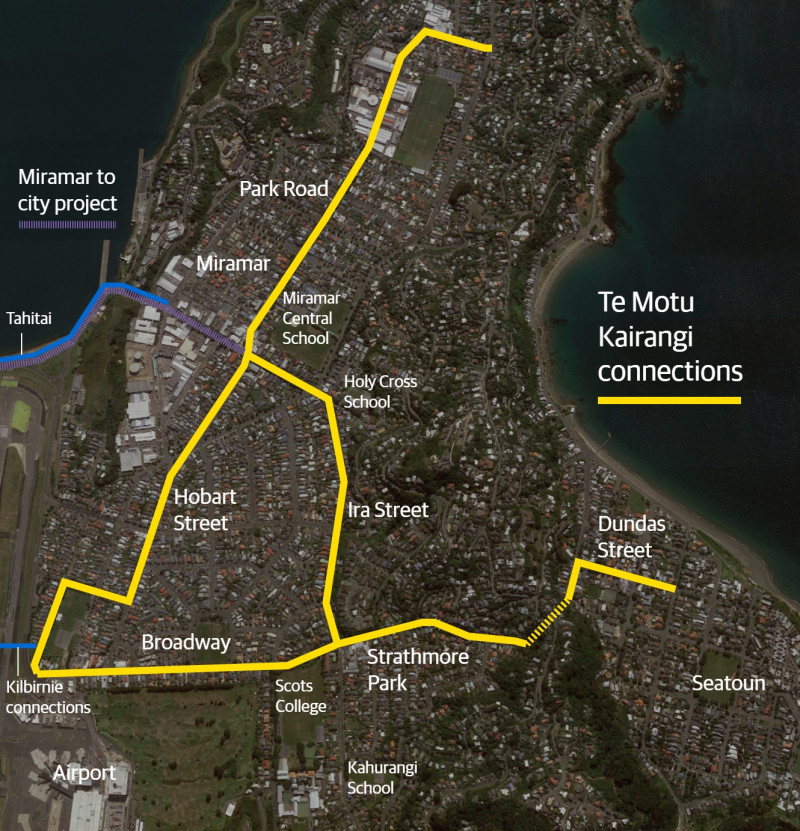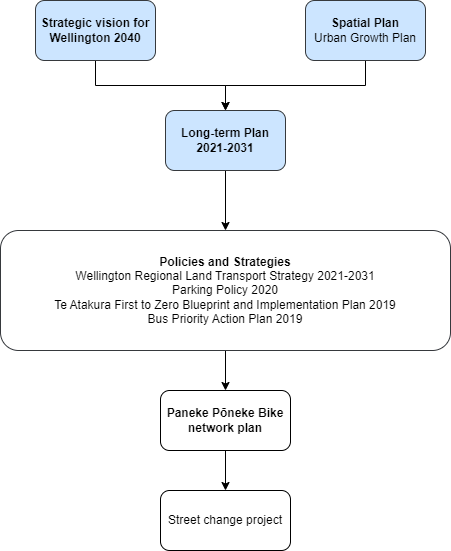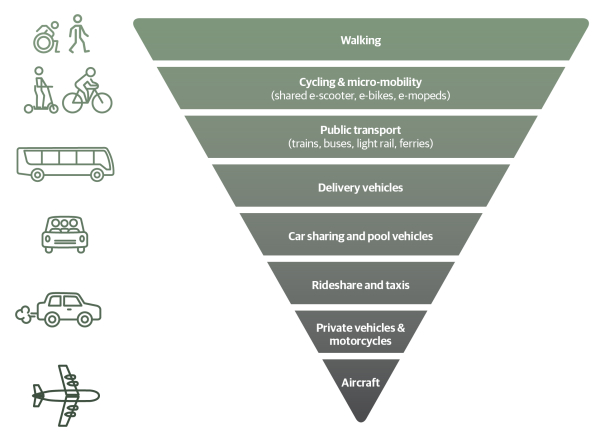
He tāone e hāngai ana ki te anamata
A city fit for the future
Te Motu Kairangi connections is one of many projects to provide safer and easier options to walk, bike, or bus – so more of us can get places in climate-friendly ways.
This project involves improvements in Miramar, Strathmore, and Seatoun.
Wellington is growing, and more people will be living in apartments or townhouses. Development like this is already happening in parts of the eastern suburbs.
To support this growth, we’re making changes on some streets.
The goal is to be a city where people of all ages and abilities can move safely and easily by bike, bus or on foot, reducing congestion and emissions. These essential street changes will make it easier for more of us to be less reliant on our cars – now and in the future.
Safer bike routes and connections
The planned routes in Miramar will connect with other bike paths and connections in Kilbirnie, to Lyall Bay, and around the bays to the central city. The changes will include improvements for people walking or taking the bus and help to make this area an even better place to live.
People will have safer and easier ways of getting to schools and early childhood centres, cafes and bars, Wellington airport, shops and businesses, Roxy Cinema, Miramar Library, community centres, parks, playgrounds, and parts of the south coast.
The streets where we're planning improvements
The four connections are:
- Miramar to the airport via Hobart, Kedah and Miro streets (1.3km)
- Miramar to Strathmore via Miramar Avenue and Ira Street (1km)
- Miramar north including Park and Camperdown roads (1.5km)
- the airport to Seatoun via Broadway, and Ferry and Dundas streets (2.1km).
How to provide input
During the project's discovery phase, the team will talk with community stakeholders, businesses, and technical experts as we develop detailed route plans. Public consultation on these plans would follow.
Our initial baseline survey was completed by 252 residents from mid-August to early October 2023. This information helps to inform the route design and will be used as part of the evaluation at the end of the project.
Stay in touch
We're keen to involve the community as we go, so we will be sending updates when there are opportunities to get involved or have your say.
Got questions about this project? Email the team: tmkconnections@wcc.govt.nz
How we got here
We first consulted on routes in the Miramar area in 2017/2018 as part of a wider eastern connections project. The biking and walking paths on Miramar Avenue between Shelley Bay Road and Tauhinu Road were completed in early 2022.
Paneke Pōneke, Wellington's bike network plan, confirmed the routes that would fill the gaps in the network, and better connect the bike paths and lanes that were already in place. The plan was approved in 2022.
Wellington is expected to grow over the next 30 years, which will dramatically affect the way our city looks, feels, and operates. If we continue at our current rate of car use, our transport network will grind to a halt.
Our goal is to be a city where people of all ages and abilities can move easily and freely in low-carbon ways. These essential street changes will make it easier for more of us to be less reliant on our cars.
We’re changing our streets to make it safer and easier for people to walk, ride, scoot, or use public transport. The changes we’re developing will take time to get used to, but we need to adapt to make sure we can still get around.
In line with Council strategies, policies, and plans, we have developed Paneke Pōneke, a citywide bike network plan. Changes as part of Paneke Pōneke will happen alongside improvements for people walking, scooting, and taking the bus.

Making it safe and easy to bike, walk, and use public transport for everyday trips is key to rapidly cutting emissions in Wellington. It’s vital that we create a connected network, particularly for beginners and less confident riders, as well as people who are experienced riders, so that more of us can get around more often in low carbon ways.
The following strategies, policies, plans and research provide the context for the development of a safe, connected and high-quality bike network alongside other sustainable transport improvements.
Sustainable transport hierarchy
Our sustainable hierarchy was first adopted in the Urban Growth Plan 2015 (now superseded by the Spatial Plan). The hierarchy prioritises movement by walking, biking, and public transport, so that our city’s streets work better for people.

Paneke Pōneke Bike Network Plan 2022
The bike network will connect suburbs to the city centre and destinations, helping to get people of various ages and abilities from where they live to where they work, study, shop, and play. Paneke Pōneke, Wellington’s bike network plan, was adopted in March 2022.
We consulted on the bike network plan between 2 November – 14 December 2021 as part of the Our City Tomorrow engagement. This engagement also included the draft District Plan and options for mass rapid transit routes through Let’s Get Wellington Moving.
Long-term Plan 2021-2031
The Long-term Plan updated the city outcomes and priority objectives. It also provided $226 million over 10 years to develop a bike network. This is supported by investments in Let's Get Wellington Moving, which will provide for safe biking in the city centre and key corridors connecting to the city centre.
Spatial Plan 2021
The Spatial Plan 2021 provides a blueprint for more housing to accommodate a growing population over the next 30 years. This includes supporting tens of thousands more people to live in the inner-city suburbs and within walking distance of the city centre and rapid transport stops.
A well-connected walking and biking network is key to accommodating more people in the city without adding to car congestion or putting pressure on our bus services.
Greater Wellington Regional Council, Wellington Regional Land Transport Plan 2021
This plan sets out the strategic direction for transport investment across the Greater Wellington region, including targets to reduce transport emissions and increase the proportion of people walking, biking, and using public transport.
Wellington Regional Land Transport Plan 2021
Parking Policy 2020
The Parking Policy provides a framework to guide future decision-making on the management of all Council-controlled parking spaces, and how parking supports achieving the vision for Wellington. The Parking Policy refers to the sustainable transport hierarchy, which gives highest priority to active modes of transport, such as walking, biking, and public transport. This means that when we make decisions on using road space, these active modes take a higher priority to parking.
Te Atakura First to Zero Blueprint and Implementation Plan 2019
We aim to become a net zero carbon city by 2050. Road transport emissions represent 34% of our city’s emissions – making them the single biggest source. Electric vehicles alone can’t solve this problem, given their relative expense. Making it safe and easy to bike, walk, and use public transport for everyday trips is key to rapidly cutting emissions in Wellington.
Te Atakura - First to Zero Blueprint and Implementation Plan 2019
Previous cycling strategic documents
- Wellington Cycle Network Strategic Case 2015: This outlines the challenges related to cycling and how achieving the objectives will benefit Wellingtonians.
- Cycling Framework 2015: This set out a decision-making process for the bike network and how it would be developed. It should be noted that design guidelines for what makes a safe bike lane are continually being developed and we expect to take account of current guidance as we plan improvements.
- Cycling Demand Analysis 2014: This research investigated how different types of cycling infrastructure is likely to affect the numbers of people choosing to cycle in Wellington and assessed the demand for improvements.
